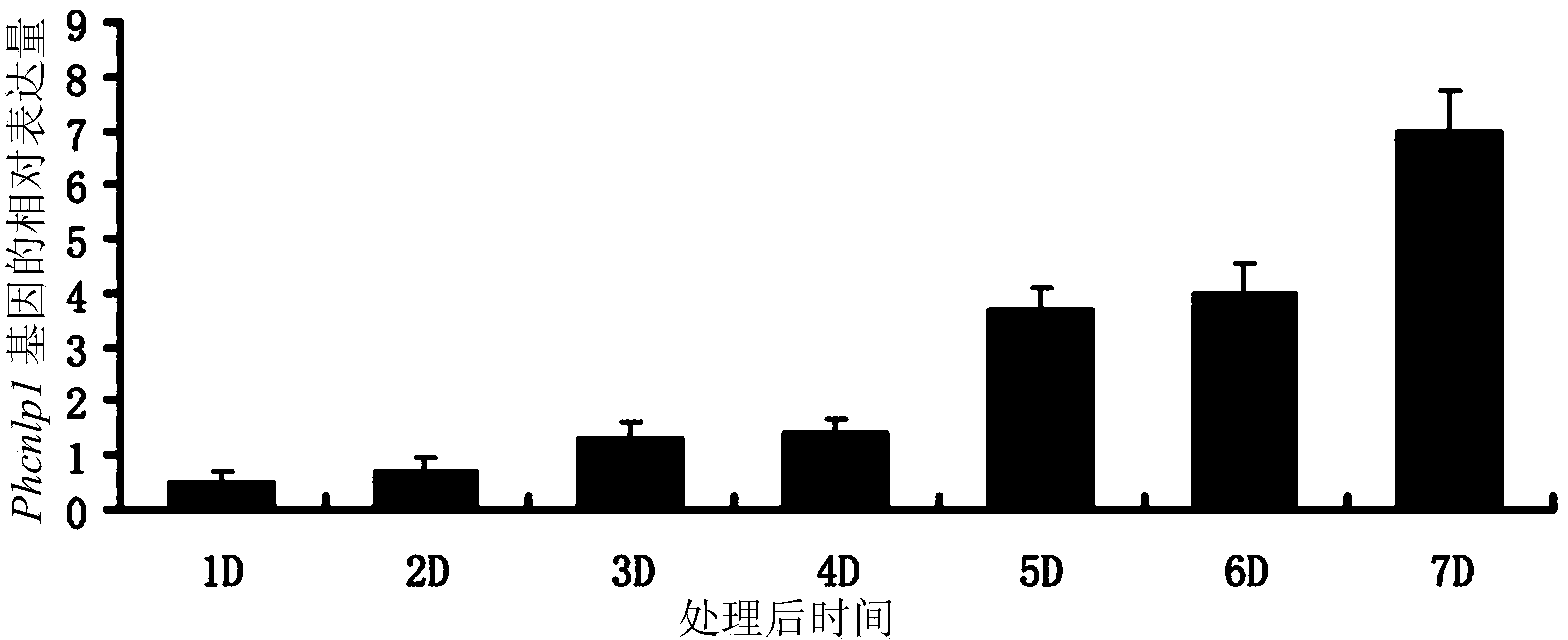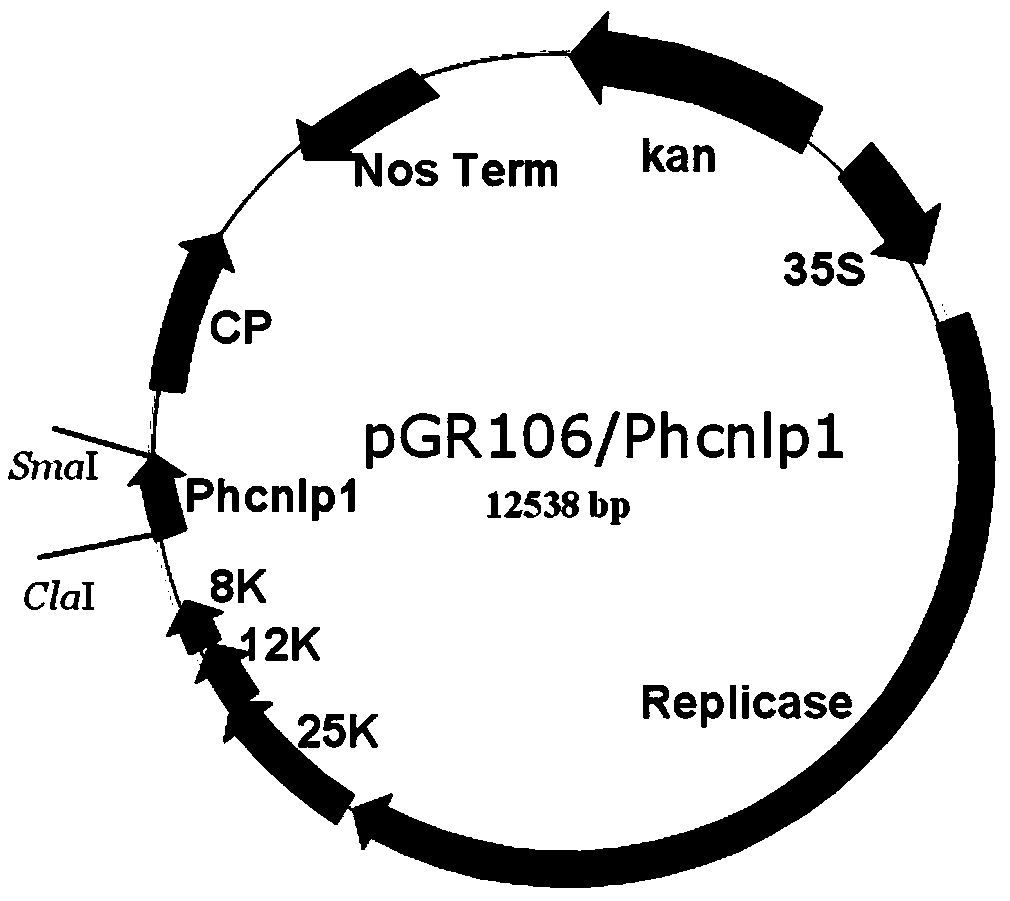Effector protein derived from phytophthora capsici as well as coding gene and application thereof
A coding and gene technology, applied in the field of molecular biology, can solve problems such as pesticide residues threatening the human living environment
- Summary
- Abstract
- Description
- Claims
- Application Information
AI Technical Summary
Problems solved by technology
Method used
Image
Examples
Embodiment 1
[0046] Embodiment 1, the acquisition of the effector protein Phcnlp1 encoding gene of Phytophthora capsici
[0047] The pathogenic Phytophthora capsici strain phy12 was selected as the test material, the genome sequence of Phytophthora capsici was analyzed according to the reported effector protein gene information, the effector protein gene in the whole genome of Phytophthora capsici was identified, and the specific primer p1 was designed and p2, use the PCR method to amplify and screen the target gene fragment, then design primers p3 and p4 according to the obtained gene fragment, and perform 3'-RACE to amplify the full length of the gene.
[0048] 1. Using the CTAB method to extract high-quality Phytophthora capsici genomic DNA
[0049] Phytophthora capsici strain phyc12 was cultured on solid oat medium (recipe: oatmeal 100g, agar 17g, water 1000ml, boiled for 30 minutes, divided into Erlenmeyer flasks, sterilized, and cooled for later use) in a 28°C biochemical incubator ...
Embodiment 2
[0097] Example 2, Phcnlp1 gene expression pattern analysis in the process of Phytophthora capsici infecting pepper host
[0098] 1. Pepper leaves inoculated with zoospores of Phytophthora capsici
[0099] 1. Zoospore preparation
[0100] (1) Transfer Phytophthora capsici strain Phyc12 to V8 medium (recipe: V8 vegetable juice 200ml, CaCO 3 3.0g, 15g of agar, add distilled water to 1000ml, boil and sterilize in a Erlenmeyer flask for later use; among them, V8 vegetable juice is commercially available) and cultivate for 4 days, pick mycelium pieces from the edge of the colony and move to fresh V8 medium for further cultivation for 4 days for later use.
[0101] (2) Pick the hyphae pieces at the edge of the colony and culture them in V8 medium, and culture them in the dark at 25°C for 5-6 days.
[0102] (3) Add sterilized water (it is better to immerse the mycelium), change the water every 1d until zoospores are produced, and adjust the zoospore concentration to 1×10 5 pieces / m...
Embodiment 3
[0135] Embodiment 3, the transient expression of Phcnlp1 gene in tobacco body
[0136] 1. Isolation of Phcnlp1 Gene Mature Peptide Sequence
[0137] According to the obtained full-length sequence of Phcnlp1 gene (sequence 2), the following primers pvxF and pvxR were designed:
[0138] pvxF: 5'-cc gctgttatcgaccacgaccaggtcgt-3' (the underlined part is the recognition sequence of ClaI, and the following sequence is the 55th-80th position of sequence 2);
[0139]pvxR: 5'-tcc ctggtaccaggcgttcgcgagct-3' (the underlined part is the recognition sequence of SmaI, and the following sequence is the reverse complementary sequence of positions 1406-1428 of sequence 2).
[0140] Using the cDNA of Phytophthora capsici strain Phyc12 as template, PCR amplification was carried out with primers pvxF and pvxR. The reaction system is 50 μL: cDNA template (2 μL), 10× buffer (5 μL), Mg 2+ (4 μL), dNTP (4 μL), 1 μL each of upstream and downstream primers, Taq enzyme (0.5 μL), ddH 2 O (32.5 μL...
PUM
 Login to View More
Login to View More Abstract
Description
Claims
Application Information
 Login to View More
Login to View More - R&D
- Intellectual Property
- Life Sciences
- Materials
- Tech Scout
- Unparalleled Data Quality
- Higher Quality Content
- 60% Fewer Hallucinations
Browse by: Latest US Patents, China's latest patents, Technical Efficacy Thesaurus, Application Domain, Technology Topic, Popular Technical Reports.
© 2025 PatSnap. All rights reserved.Legal|Privacy policy|Modern Slavery Act Transparency Statement|Sitemap|About US| Contact US: help@patsnap.com



